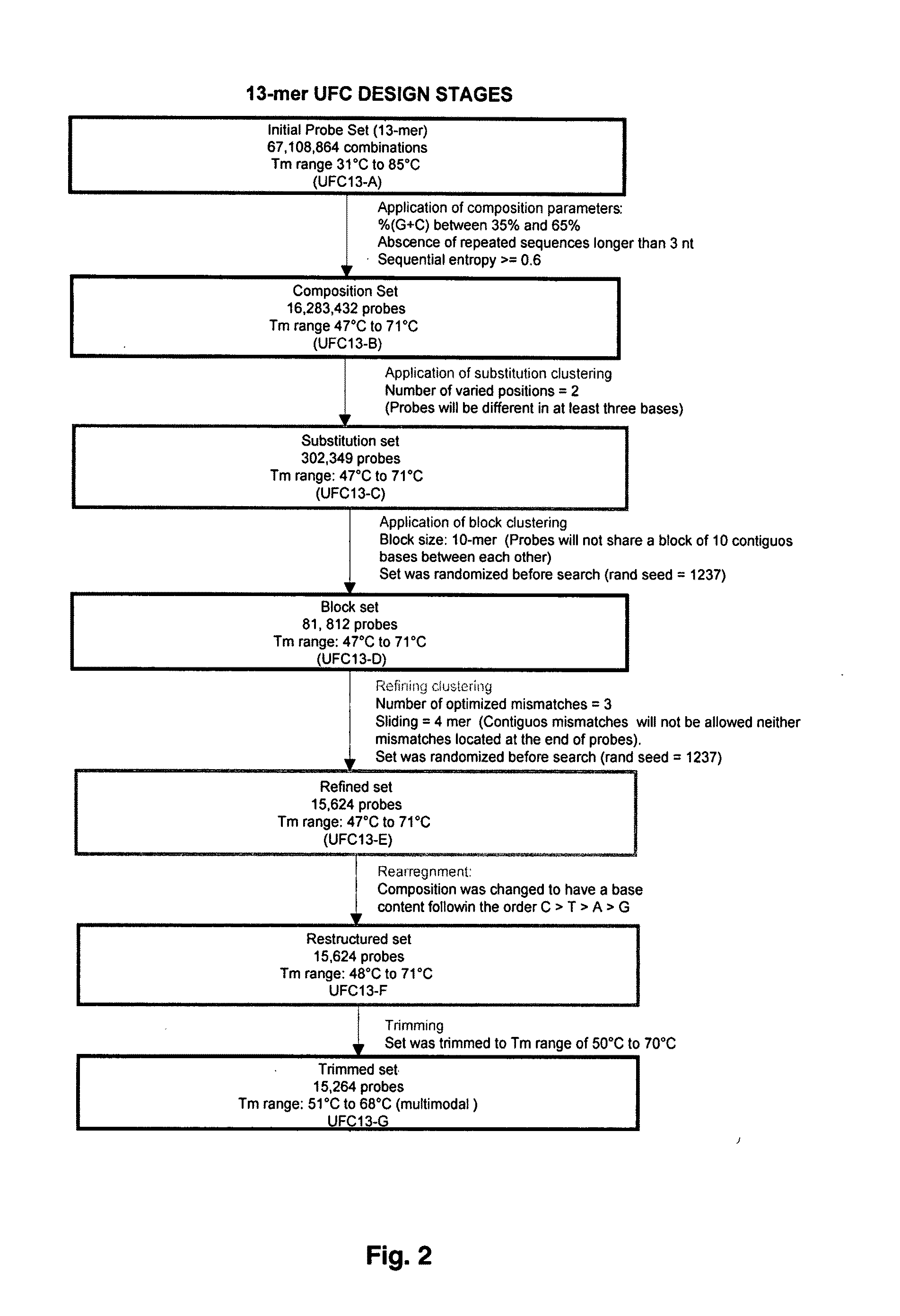Universal fingerprinting chips and uses thereof
a fingerprinting chip and fingerprinting technology, applied in the field of microarray design, can solve the problems of reducing the effectiveness of the clustering method in moderately related isolates, reducing the discriminatory power of pulsed field gel electrophoresis, and yielding a limited amount of information, so as to improve the discriminatory power of the probe, and uniform base composition
- Summary
- Abstract
- Description
- Claims
- Application Information
AI Technical Summary
Benefits of technology
Problems solved by technology
Method used
Image
Examples
example 1
Numeric Representation of Probes
[0132]The following examples describe the algorithms and software tools used for designing universal fingerprinting chips. The design of probes is aimed at maximizing the variability and specificity of the probe set while maintaining high discriminatory potential. General steps of designing universal fingerprinting chips are shown in FIG. 6.
[0133]An important issue of the algorithms is the numeric representation of sequences. A specific numeric representation is assigned to each probe sequence. This number is a unique integer value which is calculated from the sequence assuming that A=0, C=1, G=2 and T=3. Therefore, each probe sequence is equivalent to a numeric value in base 4, which in turn is converted to a number in base 10 (the numeric representation of the probe). In this way each probe sequence has a unique numeric value between 0 and 4L−1, where L is the length of the probe. This numeric representation of short sequences has been described (Wa...
example 2
Overall Clustering Strategy
[0135]A clustering strategy is used to produce a set of probes where all the probes are different in at least a minimum number of bases defined by the user. This strategy consists of searching an available probe in the table. This sequence is marked as the n-mark of the n-cluster and is stored in an independent table of cluster marks. Then the remaining available probes in the table are compared with this n-mark using any of the similarity criteria described above. If a probe exhibits a similarity with the n-mark, then it is assigned to the n-cluster and is marked as non-available. Once all available probes are compared and clustered with the n-mark, a new (n+1)-mark for a new (n+1)-cluster is selected from the remaining available probes, and the procedure is repeated. This strategy is performed until all probes in the table have been clustered and marked as non-available. Probes contained in the resultant table of marks will not share the similarity crite...
example 3
Substitution Cluster
[0136]When probes are clustered under this criterion, a cluster is integrated by all those probes which have a maximal number of base differences (substitutions) with respect to the mark of the cluster when probes are aligned and compared along their entire lengths.
[0137]As the classical procedures for character comparison between strings are very time consuming, a different strategy was implemented to locate all those similar probes to the mark of the cluster. In this strategy all general substitution patterns for a probe of a defined length are calculated considering the maximal number of base differences. These patterns show all base substitutions that must be produced in the sequence of a probe (the cluster mark) to generate a new sequence that is now different in a defined number of bases. For example, if 0 represents the constant positions and 1 the positions to be varied, the substitution patterns (masks) of one and two bases that can be made from a 5-mer ...
PUM
| Property | Measurement | Unit |
|---|---|---|
| Tm | aaaaa | aaaaa |
| Tm | aaaaa | aaaaa |
| Tm | aaaaa | aaaaa |
Abstract
Description
Claims
Application Information
 Login to View More
Login to View More - R&D
- Intellectual Property
- Life Sciences
- Materials
- Tech Scout
- Unparalleled Data Quality
- Higher Quality Content
- 60% Fewer Hallucinations
Browse by: Latest US Patents, China's latest patents, Technical Efficacy Thesaurus, Application Domain, Technology Topic, Popular Technical Reports.
© 2025 PatSnap. All rights reserved.Legal|Privacy policy|Modern Slavery Act Transparency Statement|Sitemap|About US| Contact US: help@patsnap.com



